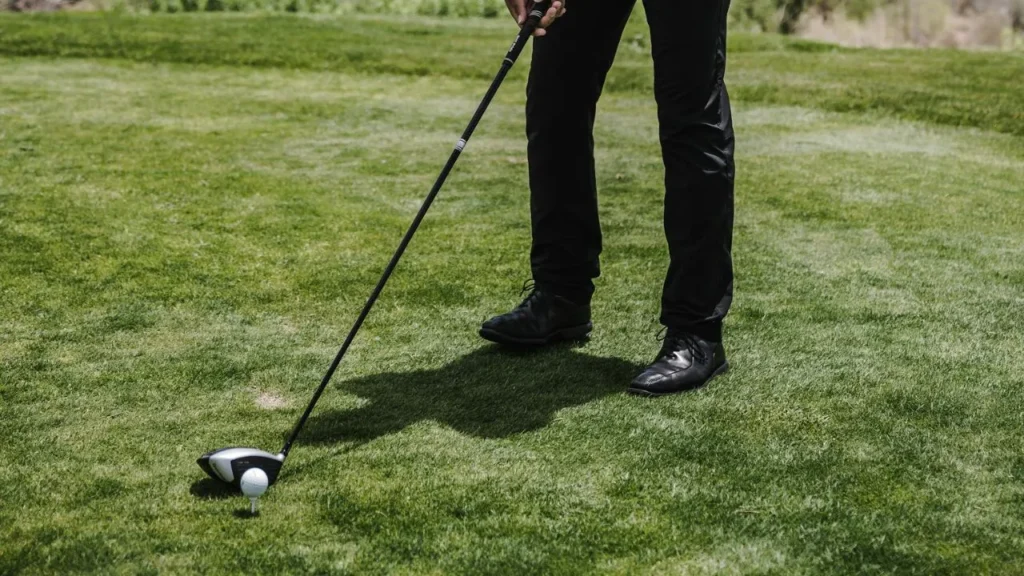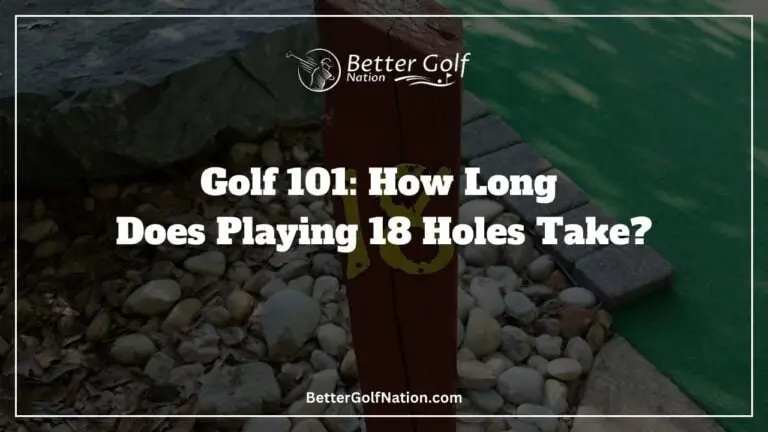Hitting Driver Too High? How to Fix It for Lower Flight!
Discover why hitting the driver too high affects your golf game. Learn how swing mechanics, setup adjustments, and proper equipment can help you hit longer and more accurate drives.

Key Takeaways
- Improving swing mechanics through proper technique lowers high driver shots by optimizing launch conditions and reducing backspin for greater distance and accuracy.
- Adjusting tee height and ball position allows golfers to control trajectory, ensuring more consistent and precise drives with better launch angles.
- Equipment matters, so consider using lower-spin golf balls and properly fitted drivers to enhance performance and achieve desired shot shapes.
- Focus on achieving solid contact at impact to lower spin rates and maximize roll-out distance, resulting in longer drives and improved overall performance on the course.
- Incorporate drills with fairway woods and irons into practice sessions to develop the skill of hitting down on the ball, promoting a lower trajectory and more controlled ball flight off the tee.
Hitting the Driver Too High: Understanding the Problem
Hitting the driver too high can be a frustrating experience for any golfer. When you hit up on the ball with your driver, it can result in a popped-up shot that lacks distance and accuracy.
A high-ball flight is also more prone to wind interference, making it harder to control your shots. There are several reasons why you might be hitting your driver too hard.
One of the primary factors is the angle of impact between your clubface and the golf ball. If your swing is too steep, you’ll tend to hit up on the sweet spot of your driver, producing that frustrating high trajectory.
To avoid this issue, golfers must work on their swing mechanics and adopt a flatter swing plane. Another major factor that contributes to hitting up on the ball is incorrect driver setup and ball position.
A lot of golfers need to consider their swing’s natural arc or the club’s loft angle to avoid using a standard tee height. For example, if you tee up too low, you may end up hitting downward on the ball with a steep angle of attack, resulting in unwanted slices or hooks.
Enjoying this article? Read more:

Check out this video below from Golf Distillery‘s YouTube channel, where they show How to Fix Too High Golf Shots with your Driver:
On the other hand, if you place the tee too far forward or back in your stance, it will contribute to popping up your driver. To improve drive distance and reduce erratic pop-ups with your driver, try adjusting how you set up your address while teeing off.
First things first: check that you are using an appropriately lofted club for your skill level and that it matches well with other clubs in your bag; then consider adjusting how high or low you tee up based on different factors such as wind strength/direction or desired shot shape/control. The equipment also plays an essential role in controlling ball flight characteristics when hitting drivers.
Choosing a lower spinning golf ball can help reduce ballooning shots while selecting drivers with higher lofts could help prevent popping it up with drivers due to not having enough launch angle for their swing speeds. A good starting point is to focus on getting fitted for the right type of driver and ball that suits your swing characteristics, which can help you hit the ball more accurately and further down the fairway.

The Science Behind the Shot
To understand the science behind hitting the driver too high, we first need to examine launch conditions. Launch conditions refer to the angle at which the ball leaves the clubface and its initial velocity.
The angle of attack—that is, the direction from which you swing your clubhead into the ball—also plays a role in determining launch conditions. In general, a golfer who swings up on the ball will create more loft and spin than one who swings down on it.
One of the most common causes of hitting the driver too high is skying the driver or making contact with the upper half of the golf ball. This often results in a high launch angle and excessive backspin, causing your shot to balloon in mid-air before falling short of its intended target.
Skying can occur when you don’t place your tee high enough or when you hit up too much on the ball. Another factor that contributes to high-trajectory shots with your driver is the ball position at setup.
"Understanding the science behind hitting the driver too high requires delving into launch conditions—how the ball leaves the clubface and its initial velocity. Factors like angle of attack and tee placement significantly influence shot trajectory and spin."
If you move your tee too far forward and place it even slightly ahead of where it should be, you are likely to hit higher shots than intended. In contrast, placing your tee too far back can cause you to hit down on the ball excessively, generating a lower shot that lacks carry distance.
The correct position for swinging up on a driver depends on both your physical ability and style preference. As a general rule of thumb, most PGA pros recommend setting up with approximately 55% of your weight on your lead foot and positioning yourself so that only about half an inch or so of your left heel is visible from behind while looking down over it.
When hitting the driver off a tee box for maximum distance potential, as opposed to an iron or wedge, solid contact at impact is essential for promoting optimal launch conditions as well as ideal ball flight characteristics such as low spin rates for long roll-outs after landing.
To fix high driver shots, you’ll have to work on your setup and swing technique to reduce the amount of loft and spin you create at impact. Consider working with a golf professional to get expert tips and drills tailored specifically to your swing.
Enjoying this article? Read more:

Identifying the Causes of Hitting Your Driver Too High
If you’re hitting the driver too high, there are a few potential culprits to consider. One common issue is hitting up during the swing.
When you hit up on the golf ball, it can create an excessive launch angle and increase backspin, leading to higher shots that don’t travel as far as they could. This is particularly true if you’re not hitting the ball in the sweet spot of your driver’s face.
Another potential cause is your approach angle. If you’re coming at the ball too steeply, your clubface may be open at impact, which could lead to drives going straight up into the sky rather than downrange.
To fix this problem, focus on hitting down on the golf ball and improving your approach angle. You can practice this by using an impact tape drill or working with a teaching professional who can analyze your swing.
Your equipment may also be contributing to high driver shots. If you’re using a driver with a shaft that’s too stiff for your swing speed or style, it can create an excessive spin and launch angle that sends balls soaring into space instead of downrange where they belong.
Consider trying out different drivers until you find one that works well for you. Many golfers have had great success with clubs like the hybrid mini driver or AT705 driver. Make sure your setup is correct when addressing the ball; specifically, pay attention to the shaft position at setup.
If your hands are too far forward or back relative to the club head at address, it can impact how well you hit the ball and contribute to high shots off of tee shots and even iron + wedges. Fixing these issues can dramatically improve driver performance and help you stop popping up all those shots off of the tee box!
Check out this video below from PXG‘s YouTube channel where they discuss how to lower the driver ball flight:
Enjoying this article? Read more:

How to Correct High-Hitting Drivers
There are a few ways to correct high-hitting drivers. The first step to fixing the issue is to identify what’s causing it.
Once you figure out the cause, you can work on making changes to your swing and setup to improve driver performance and stop hitting drives high. One common cause of hitting the driver too high is an over-the-top swing.
This happens when your downswing starts from outside the target line, causing you to come across the ball at impact with a steep angle of attack. To fix this, try starting your downswing from inside the target line and focusing on swinging more shallowly through impact.
This will help create a sweeping motion that lowers your launch angle. Another cause of hitting the driver too high is an upright swing or standing too tall at the address.
This can lead to skying the driver or even popping up shots off the tee. The fix for this is simple: make sure you’re in a proper golf position at address with your spine tilted slightly away from the target and your weight balanced between both feet.
For some golfers, using a low-spin driver may be necessary if they’re struggling with excessive backspin on their drives. These drivers are designed to produce less spin than traditional drivers, which can help lower launch conditions and keep shots from ballooning into the air.
It’s important to make sure you’re making solid contact at impact. Hitting the sweet spot on your driver will result in better launch conditions and more distance off the tee.
Work on improving your impact angle by focusing on keeping your hands ahead of the ball through impact and swinging through rather than up at contact. By making these adjustments in golf driver techniques, you should be able to fix high driver shots and stop hitting drives high for good!
Enjoying this article? Read more:
Check out this video below from the Rick Shiels Golf YouTube channel where he discusses how to stop striking too high on the driver’s face:
Drills to Lower Your Ball Flight
Struggling with consistently high drives? Fear not, as several drills can assist in bringing down your ball flight. By implementing targeted practices and adjustments to your setup and swing, you can soon bid farewell to those soaring shots off the tee.
Drills for a Lower Trajectory:
- Divot Board Drill: Place a divot board behind the ball at address. Focus on making clean contact with the board after hitting the ball, promoting a steeper swing path for a lower launch.
- Feel Drill: Imagine hitting the ball “down on the screw head” during impact. This visual cue encourages a downward strike, reducing the launch angle.
- Shallow Out Drill: Make practice swings where you consciously shallow out your swing plane in the downswing, promoting a more level attack on the ball for a lower flight.
Additional Techniques and Adjustments:
- Fairway Wood Practice: Utilize three- or five-woods off the tee to encourage a downward strike, fostering a sweeping motion and reducing upward contact, resulting in a lower ball flight.
- Setup Adjustment: Ensure the ball position isn’t excessively forward in your stance, aiming to place it just inside your left heel for optimal impact and launch control.
- Spine Tilt: Maintain sufficient tilt away from the target at address to encourage an outward swing path, aiding in lowering the trajectory.
- Tee Height Modification: Experiment with lowering the tee by half an inch to minimize deflection at impact, resulting in a flatter trajectory.
- Diversify Tee Shots: Incorporate irons and wedges into your tee box routine for lower spin and greater control over launch conditions compared to drivers.
By integrating these drills and adjustments into your practice regimen, along with varying your tee shot selections, you’ll gradually master the art of controlling your ball flight. With dedication and refinement of technique, those once troublesome high drives will become a thing of the past, paving the way for more consistent and controlled tee shots.
Enjoying this article? Read more:

Professional Tips and Insights
Welcome to a treasure trove of professional tips and insights aimed at refining your golf game to perfection. If you find yourself sending the ball sky-high with your driver, fear not! PGA pros have shared their wisdom to help you navigate this common challenge and unleash your full potential on the course.
- Optimize Tee Height: Lowering your tee can significantly reduce excessive ball flight height. Experiment with various tee heights to find your sweet spot.
- Perfect Your Setup: Ensure the correct setup and ball position to avoid steep impact angles, which can lead to high ball flights.
- Check Stance and Alignment: Maintain a wide stance and proper alignment to the target line. Confirm that the ball is positioned correctly in your stance to control the trajectory effectively.
- Consider Equipment Adjustments: Explore options like low-spin drivers or stiffer shafts to mitigate high drives and gain better control over your shots.
- Focus on Downward Impact: Contrary to intuition, focusing on hitting down on the ball promotes a penetrating trajectory, maximizing distance and accuracy while minimizing excessive elevation.
Incorporating these insights into your practice regimen and on-course strategy can revolutionize your driving game. By refining your technique and making subtle adjustments, you’ll soon be sending laser-straight drives down the fairway, leaving those high-flying shots behind.
So, grab your clubs, hit the range, and embrace the journey to becoming a more consistent and confident golfer!

Enjoying this article? Read more:
Check out this video below from Club Champions YouTube channel where they discuss hitting a driver too high and causing you to lose distance:
Common Mistakes and How to Avoid Them
Are you struggling to keep your drives low and penetrating? Avoiding common mistakes in your setup and swing can make a significant difference in your ball flight. Here are some tips to help you steer clear of these errors and achieve more consistent drives:
Incorrect Ball Position: Placing the ball too far forward in your stance can lead to hitting the driver too high. Aim to position the ball just inside your front heel to ensure a better angle of attack at impact, resulting in solid contact and a lower trajectory.
Hitting Up at Impact: While it’s beneficial to hit up on fairway woods, doing the same with the driver can cause a ballooning effect. Instead, focus on making contact with the ball while hitting down slightly on it, which will help compress the ball against the clubface for a more penetrating flight.
Excessive Swing Speed: Swinging too fast or with an overly aggressive swing path can lead to off-center strikes and higher trajectories. Try slowing down your swing tempo and focusing on maintaining solid contact to improve your driver performance.
Improper Posture or Stance: Leaning back at address or standing too tall during your swing can increase loft angle at impact, resulting in higher shots. Work on maintaining a proper spine angle and weight distribution between both feet to prevent this from happening.
By avoiding these common mistakes, you can improve your overall game and prevent pop-up ball flights, whether you’re hitting up with fairway woods or striving to increase driving distance by hitting the sweet spot of the clubface.
Don’t let common mistakes sabotage your drives! By making small adjustments to your setup and swing, you can achieve a more desirable ball flight and enhance your performance on the course. Whether it’s adjusting your ball position, refining your swing tempo, or perfecting your posture, focusing on these key areas can lead to more consistent and enjoyable rounds of golf.
So next time you tee it up, remember these tips to keep your drives flying long and true.
Enjoying this article? Read more:

Conclusion
High-hitting drivers can be frustrating, and it’s essential to address the problem if you want to improve your golf game. The pop-up problem is often a result of incorrect ball position and tee height for the driver.
By adjusting your technique and making some simple changes, you can fix your high-drive ball flight. Remember that hitting the sweet spot is crucial when it comes to lowering your ball flight.
It produces less backspin, which will keep the ball from launching too high into the air. You should also consider using a hybrid mini-driver as an alternative to your regular driver if you find that you have difficulty with steep swings.
Clubhead speed is another factor that affects ball flight. If you’re swinging too hard, it could cause an increase in backspin and launch angle.
It’s important to focus on consistency rather than pure power when it comes to hitting the golf ball. By following some of the tips and insights provided by professional golfers, such as adjusting the swing plane or using iron + wedges off the tee instead of a driver, you can achieve maximum carry distance while minimizing high driver shots.
Don’t let a pop-up problem keep you from enjoying golf; adjust your swing technique and experiment with different tee heights until you find what works best for your game. Lowering your high-hitting drives will take time and dedication, but with patience and practice, there’s no reason why anyone can’t improve their performance on the course!

FAQs
Why am I hitting my driver so high, and is it hurting my distance?
You might be hitting your driver high due to several factors like swing mechanics (swinging up on the ball), tee height (too high), ball position (too far back), or equipment (stiff shaft, high loft driver). Yes, a high ball flight can hurt distance. While it creates more hang time, it also reduces roll on the fairway, leading to shorter drives.
How can I fix a high driver ball flight for a lower, more penetrating trajectory?
There are several ways to achieve a lower, penetrating flight. Look at your swing mechanics – focus on hitting down on the ball, not up. Experiment with tee height (lower it slightly), and adjust your ball position (slightly forward). Consider equipment – a proper fitting might reveal a shaft or loft contributing to the high flight.
Is there a quick and easy way to stop ballooning my drives?
A simple fix is to lower your tee height. This promotes a more downward swing path and reduces loft at impact. However, this might not be a long-term solution if swing mechanics are the root cause.
Do I need to change my swing mechanics completely to hit the driver lower?
Not necessarily. Focus on making subtle adjustments: shift your weight slightly forward at address and swing down on the ball with a more level swing path. Practice drills like hitting balls off a tee placed on a driving range mat to promote a downward strike.
Should I adjust my tee height or ball position to control driver launch angle?
Both tee height and ball position can influence launch angle. A lower tee height encourages a descending swing path for lower launch. Moving the ball slightly forward in your stance can also help achieve the same effect.
Can my driver shaft or loft be contributing to my high ball flight?
- Yes, your equipment can play a role. A stiff shaft can promote a higher launch, while a high loft driver is naturally designed for more lift. Consider getting fitted for a driver with a shaft that matches your swing speed and a loft that suits your desired launch angle.
What are some drills I can practice to improve my ability to hit the driver lower?
- Divot Board Drill: Place a divot board behind the ball at address. Focus on making clean contact with the board after hitting the ball, promoting a steeper swing path.
- Feel Drill: Imagine hitting the ball “down on the screw head” during impact. This visual cue encourages a downward strike.
- Shallow Out Drill: Make practice swings where you consciously shallow out your swing plane in the downswing, promoting a more level attack on the ball.
How can I tell if I'm hitting the driver on the sweet spot to optimize launch angle?
A pure strike on the sweet spot typically produces a solid feeling and a clear, loud sound. You can also check for ball flight – a well-struck drive will have a boring trajectory with good roll after landing.
Are there any specific driver fitting options that can help me achieve a lower ball flight?
Absolutely! A professional fitter can analyze your swing and recommend a driver with a lower loft or a specific shaft flex that promotes a lower launch angle for your swing dynamics.
Compared to other golfers, what is an ideal driver launch angle for me?
Launch angle is an individual characteristic depending on swing speed and desired ball flight. Generally, a driver launch angle between 10-14 degrees is considered optimal for most golfers. However, a fitter can help you determine the ideal launch angle for your specific swing and goals.
Share this Post
Toni Benedito
Keep Reading
Follow Us
Recent Posts

How Do Pro Golfers Get Paid? The Business of Golf
Professional golfers get paid both before and after tournaments. Before a tournament, they receive appearance fees, sometimes exceeding $1 million, to attract top players. After the tournament, earnings depend on their placement, with the PGA

How Much Do Golf Players And Pros Make? You Won’t Believe It!
Professional golfers earn substantial incomes through tournament winnings, sponsorship deals, and endorsements. Top players on the PGA Tour can make millions annually, with significant earnings from prize money and lucrative brand partnerships. For example, Rory

The Shocking Cost: How Much Does It Cost to Fly with Golf Clubs?
Flying with golf clubs can be a hassle, but it’s worth it for avid golfers. Costs vary by airline, ranging from $30 to $150 per way. Southwest Airlines offers a generous policy, allowing one set

Why Do Golfers Tape Their Fingers Before Hitting the Course?
Golfers tape their fingers to prevent injuries from repetitive motions, provide support for existing injuries, and improve grip comfort. It’s a popular technique among amateurs and pros alike, offering a lightweight and effective solution compared

How Much Does a Round of Golf Cost? Are You on Par?
The cost of a round of golf varies widely based on factors like course type, location, and time of play. Public courses typically range from $30-$100 per round, while exclusive ones like Augusta National or

Hidden Fees: How Much Does It Cost To Rent a Golf Cart
Wondering how much it costs to rent a golf cart? Explore factors like location, rental duration, and cart type impacting prices. Daily rates range from $50 to $80, while weekly rentals can vary from $200
Table of Contents







